Vasilopita is a Greek New Year’s bread (or cake) with a lucky coin hidden within. This vasilopita recipe is made of layers of cinnamon-scented dough with a delicious sweet and savory combination of flavors and toasted sesame seeds. Big thanks to Karen Stoeckle for sharing her family recipe!
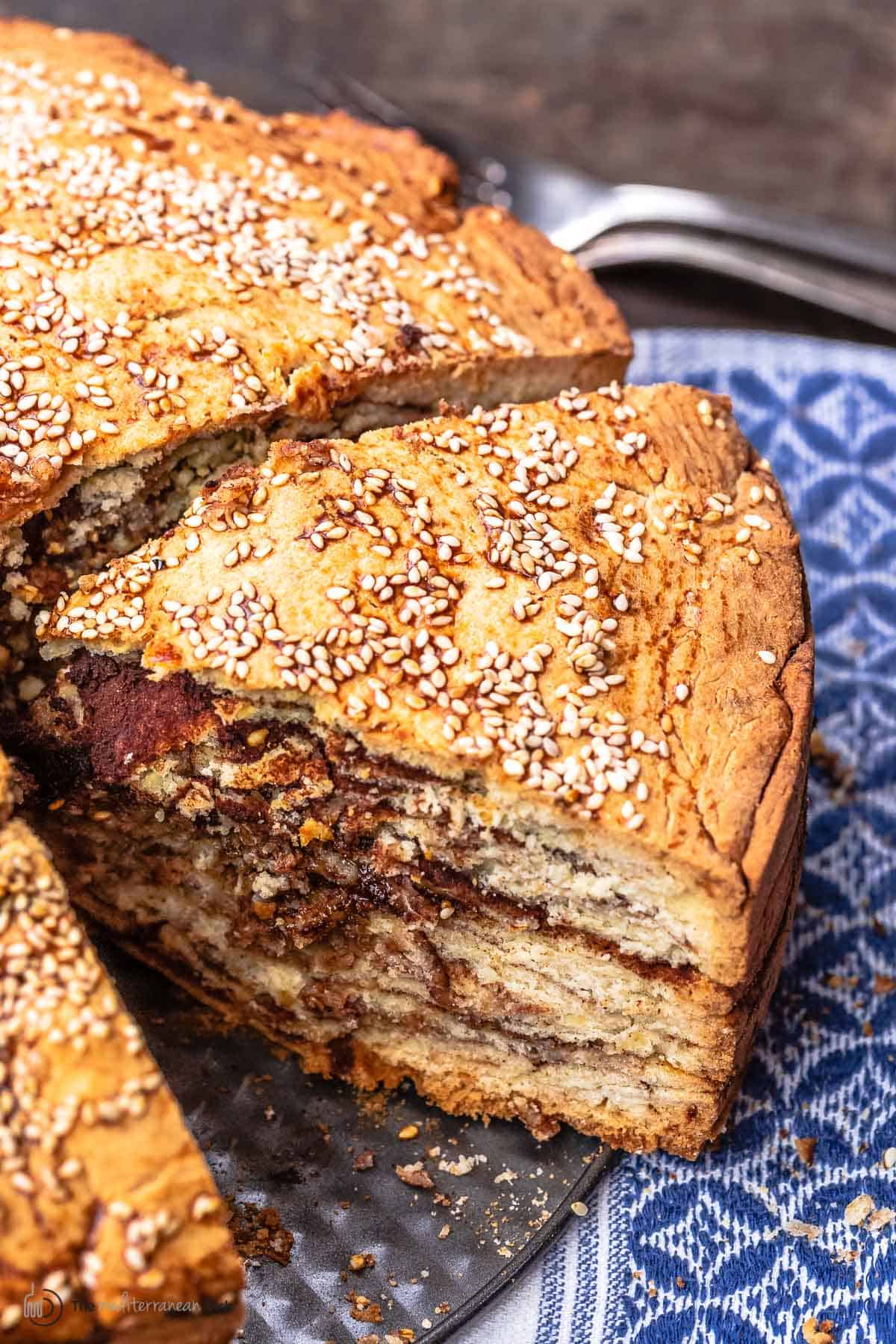
A few weeks ago, I asked my readers to share family holiday recipes they cherished. I was thrilled to see Karen Stoeckle’s vasilopita, a Greek lucky New Year’s bread recipe passed down to her through her Greek grandparents Mary and Gregory Matjouranis who moved to the States from Mytilene, Greece as a young couple.
Karen grew up with the tradition of making and cutting vasilopita bread every New Year’s Day, and she started making it on her own when she was just 16 years old. I loved hearing that the year she found the lucky coin is when Karen also met her husband!
I found Karen’s Greek new year’s bread recipe so unique compared to what I’ve read elsewhere online, and I’m very excited to share it with you!
What is vasilopita?
Vasilopita (pronounced vah-see-lo-pita) is a traditional Greek New Year’s bread (or cake) served at midnight to bring good luck into the new year. This bread is made extra special by the fact that a coin is hidden within it, and the person who finds it is said to have good fortune for the whole year ahead!
About this New Year’s bread recipe
There are variations of vasilopita. Some are sweet cake recipes, while others are more of a bread.
This recipe from Karen’s Greek grand parents is a bread recipe made of thin layers of dough, flavored with sweet and savory flavors from a cinnamon and sugar mixture and grated Romano cheese, which is a unique twist (you can omit the cheese if you’re looking for a sweet bread).
Decorating vasilopita also varies from one family to another. Some dust the vasilopita generously with powdered sugar, while others finish it with a sugar glaze or a sprinkle of pomegranate or sesame seeds (as in today’s recipe).
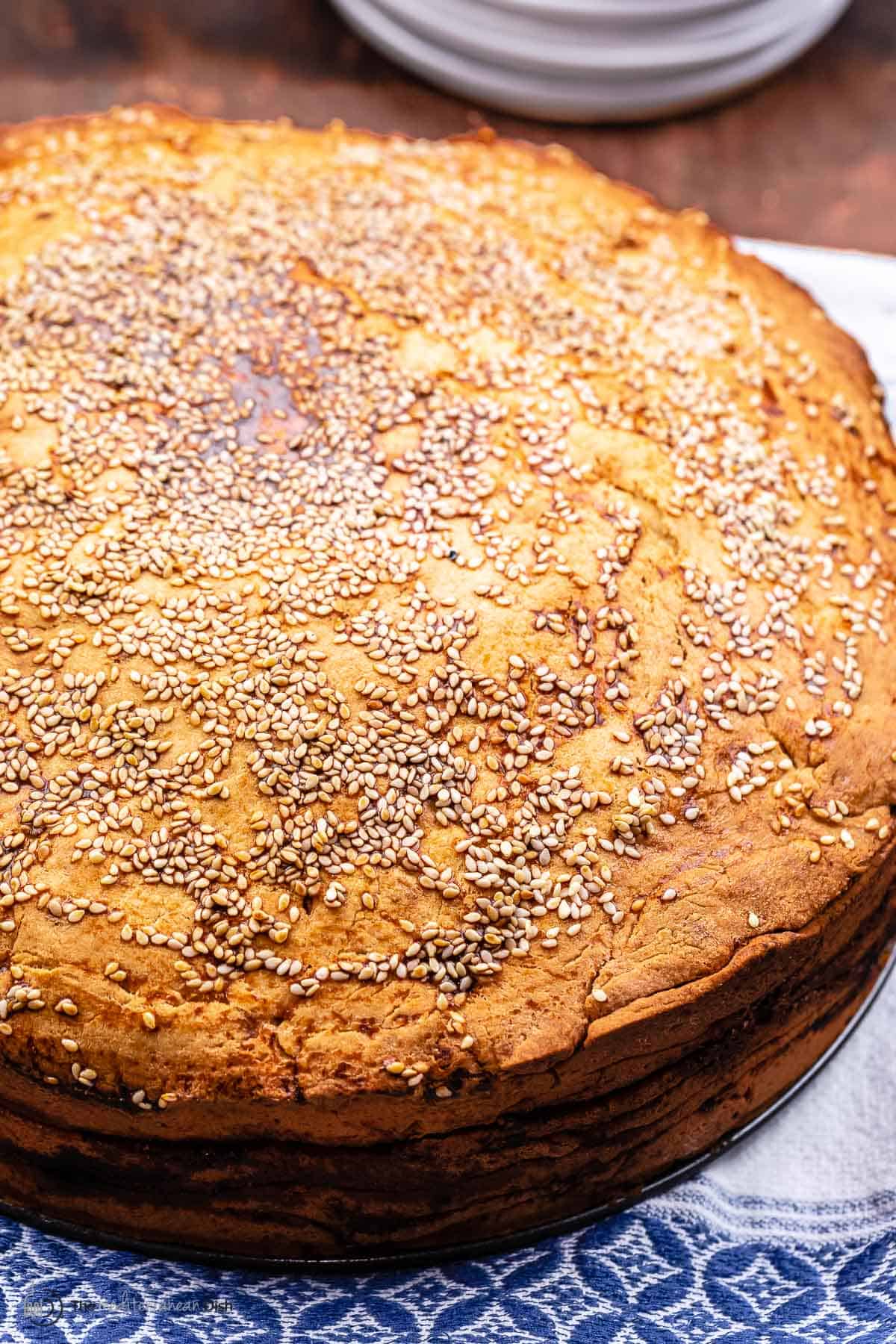
The ritual of cutting and serving vasilopita
Traditionally, vasilopita is meant to be made and served at midnight on New Year’s! There is a bit of religious component when it comes to slicing and serving this special bread—the first two slices being for Christ and Mary, the third being for the house to bless it. The remaining slices are shared among the hosts, other family members, and guests (from oldest to youngest).
About the lucky coin!
Everyone who receives a slice of vasilopita has a chance of finding the coin, which can be gold or silver plated. There are coins made specifically for vasilopita, but as I do not have any of those, I used a quarter (which I wrapped in foil before inserting into the bread dough before baking). Saint Basil is said to have started the lucky coin tradition over 1,500 years ago, as he would hide jewels and coins inside bread for the poor.
Ingredients – what you need to make this recipe
- Granulated sugar – for the dough and for the cinnamon-sugar mixture
- Baking powder – to help the vasilopita rise
- Extra virgin olive oil – use good EVOO to avoid any bitterness transferring to your dough
- Romano cheese – grated and divided, for savory flavor. If you want your bread to be more on the sweet side, you can omit the cheese and use only the cinnamon and sugar mixture
- Ground cinnamon is common in Greek desserts and savory dishes, from Rizogalo (Greek Rice Pudding) to Stifado (Greek Beef Stew). Here, a little goes into the dough, and ½ cup is needed for the mixture that is sprinkled between layers of dough
- All-purpose flour – you need a whopping 10 cups, plus more for dusting
- Warm water – warm water is easily absorbed by flour, resulting in a smoother dough
- Butter – needs to be melted
- Egg yolk – you can discard the white
- Sesame seeds – to sprinkle on top of the vasilopita right before baking
- Ground cloves, allspice, and nutmeg – these warming spices go into the sweet, warming cinnamon mixture that is sprinkled between the layers of vasilopita dough
How to make vasilopita
Making this special New Year’s bread recipe takes a bit of time, but the work is worth it when you slice into delicious bread with family and friends at midnight. Here is how to make it (print-friendly recipe with ingredient measurements below).
- Make the dough. Fit a stand mixer with the whisk attachment and grab the mixer’s largest bowl. Add 2 ½ cups sugar, 2 tablespoons baking powder, 1 cup extra virgin olive oil, 1 cup grated Romano cheese, and 2 ½ cups warm water. Whisk on low to combine. Once combined, replace the whisk with the hook attachment and turn the speed to medium-low. Add the flour, 1 cup at a time. Then knead for around 5 minutes until the dough is workable. I used a wooden spoon instead of my hands because the dough is VERY sticky. Cover the dough with a towel and set aside.
- Make the cinnamon mixture. In a medium mixing bowl, mix ½ cup ground cinnamon, 1 cup sugar, ¼ teaspoon ground cloves, ½ teaspoon allspice, and ½ teaspoon nutmeg. Set this aside as well.
- Assemble the vasilopita. Lightly grease the bottom of a round 10-inch springform pan. Flour your hands, and divide the dough into 11 equal portions. Form the pieces of dough into balls (each about the size of a baseball), and place the balls on a floured surface to prevent them from sticking. On another floured surface, roll each ball of dough into a 10-inch round with a rolling pin. The round will be quite thin. Place the rolled dough into the springform pan and brush with melted butter. Sprinkle generously with the cinnamon mixture, followed by a generous sprinkle of grated Romano cheese. Repeat this process for two more layers of dough.
- Add the coin and continue to layer. If you want to keep with tradition and add the coin, be sure to wash and dry it well. Wrap it in a small piece of foil, and place it on the topmost layer of dough. Continue to layer the dough with 7 more rounds, making sure to brush each layer with butter, and to sprinkle with the cinnamon mixture and grated cheese. The last layer will be treated a little differently. After placing it on the very top, DO NOT sprinkle with the cinnamon mixture or cheese. Instead, make an egg wash by whisking 1 egg yolk and 2 tablespoons of water or milk. Brush the last layer of dough with a bit of melted butter and the egg wash. Sprinkle with sesame seeds. I used about 3 tablespoons, but you can use less depending on your preference. You could also omit the sesame seeds, and use another topping, such as almonds, powdered sugar, or dried fruit.
- Bake the vasilopita. Arrange a rack in the middle of the oven and bake the Greek New Year’s bread in a 350 degrees heated oven for 1 hour and 45 minutes. It will be a rich golden-brown color. Let it cool for a few minutes before moving it to a wire rack, and allow it to cool completely on the wire rack before you slice it.
Tips for success
- Vasilopita dough can be sticky, so I recommend lightly flouring your work surfaces
- For a sweeter bread, omit the Romano cheese and only use the cinnamon-sugar mixture.
- Use a springform baking pan: This will make removing the layered bread easier after baking.
- If using a coin, wash and dry it, then wrap it in a piece of foil. I used a quarter, but any coin will do. Just be sure to tell your guests that one of them may have a coin in their slice of bread to avoid any possible tooth damage!
How to serve it
Vasilopita is typically eaten plain, but I loved adding some honey over mine!
Vasilopita is made to be shared amongst family and friends right at midnight on New Year’s. And if you want to follow the religious tradition as mentioned earlier, then the first couple of slices are saved for Christ and Mary. From there, simply serve everyone from oldest to youngest. Each person who gets a slice stands a chance to find the lucky coin!
Leftovers and storage
This bread can be stored in an airtight container at room temperature for 3 to 5 days. If you prefer it warmed up, reheat it in a medium-heated oven for a few minutes.
Other bread recipes to try
Hungry for more? Browse more Mediterranean Recipes.
Vasilopita (Greek New Year’s Bread)
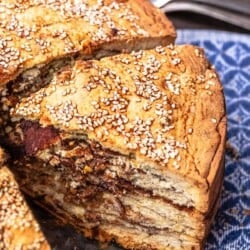
Ingredients
For the dough:
- 2 1/2 cups granulated sugar
- 2 tablespoons baking powder
- 1 cup olive oil
- 3 cups grated Romano cheese, divided (optional, you can omit the cheese if you are looking for a sweeter bread)
- ½ teaspoon ground cinnamon
- 2 1/2 cups warm water
- 8 to 10 cups all-purpose flour, plus more for dusting
- 2 butter sticks, melted
- 1 egg yolk
- 3 tablespoon sesame seeds
Cinnamon Mixture:
- 1/2 cup cinnamon
- 1 cup sugar
- ¼ teaspoon ground cloves
- 1/2 tsp allspice
- 1/2 tsp nutmeg
Instructions
- Add the sugar, baking powder, olive oil, 1 cup of the grated cheese, and water to the large bowl of a stand mixer attached with a whisk. Whisk on low speed to combine.
- Remove the whisk and add the hook attachment to the stand mixer.
- Over medium-low speed, add the flour, one cup at a time. Knead for about 5 minutes or until you have a workable dough (it will be somewhat wet still).
- Cover the dough with a towel and set aside for now.
- Make the cinnamon mixture. In a medium mixing bowl, mix together the cinnamon, sugar, cloves, allspice, and nutmeg.
- Prepare and lightly grease the bottom of a 10-inch round springform pan.
- Divide the dough into 11 equal size portions and form them into balls (you may need to flour your hands or a clean surface to help you shape the dough without sticking too much).
- On a clean lightly floured surface, working with one ball of dough at a time, use a rolling pin and roll out the dough to a thin 10-inch round. Place the first round of dough on the bottom of the prepared pan. Brush with the melted butter. Sprinkle generously with the cinnamon mixture and follow with a generous sprinkle of grated romano cheese.
- Repeat with two more layers of dough. If you’re adding the coin for good luck, wash it well and dry it then wrap it in a piece of foil and place it on top of layer of dough you just laid down.
- Continue shaping the dough balls into 10-inch rounds and layering the dough rounds on top of each other in the pan, making sure to brush each layer with the melted butter and sprinkle with the cinnamon mixture and grated cheese until the very last layer.
- Lay the last layer of dough on the very top. Combine the egg yolk with 2 tablespoons of water (or milk) and whisk. Brush the last layer of dough with a little melted butter and the egg wash. Finish with a sprinkle of the sesame seeds.
- Heat the the oven to 350 degrees F.
- Bake on the middle rack for 1 hour and 45 minutes, until the vasilopita is a rich golden-brown. Allow it to cool for about 10 minutes before moving it from the baking pan to a wire rack. Allow to cool completely before slicing.
Notes
- The grated Romano cheese is a unique twist in Karen’s recipe. It is optional, you can omit it if you are looking for a more sweet bread. (Not included in the nutrition information)
- Use a springform baking pan to make removing the vasilopita easier after baking.
- To avoid the dough sticking too much, be sure to flour your work surfaces.
- Leftovers and storage: This bread can be stored in an airtight container at room temperature for 3 to 4 days. If you prefer it warmed up, reheat in a medium-heated oven for a few minutes.
- Visit Our Shop for quality Mediterranean ingredients including extra virgin olive oils and spices.
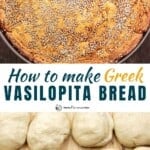
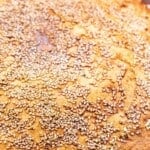
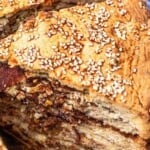
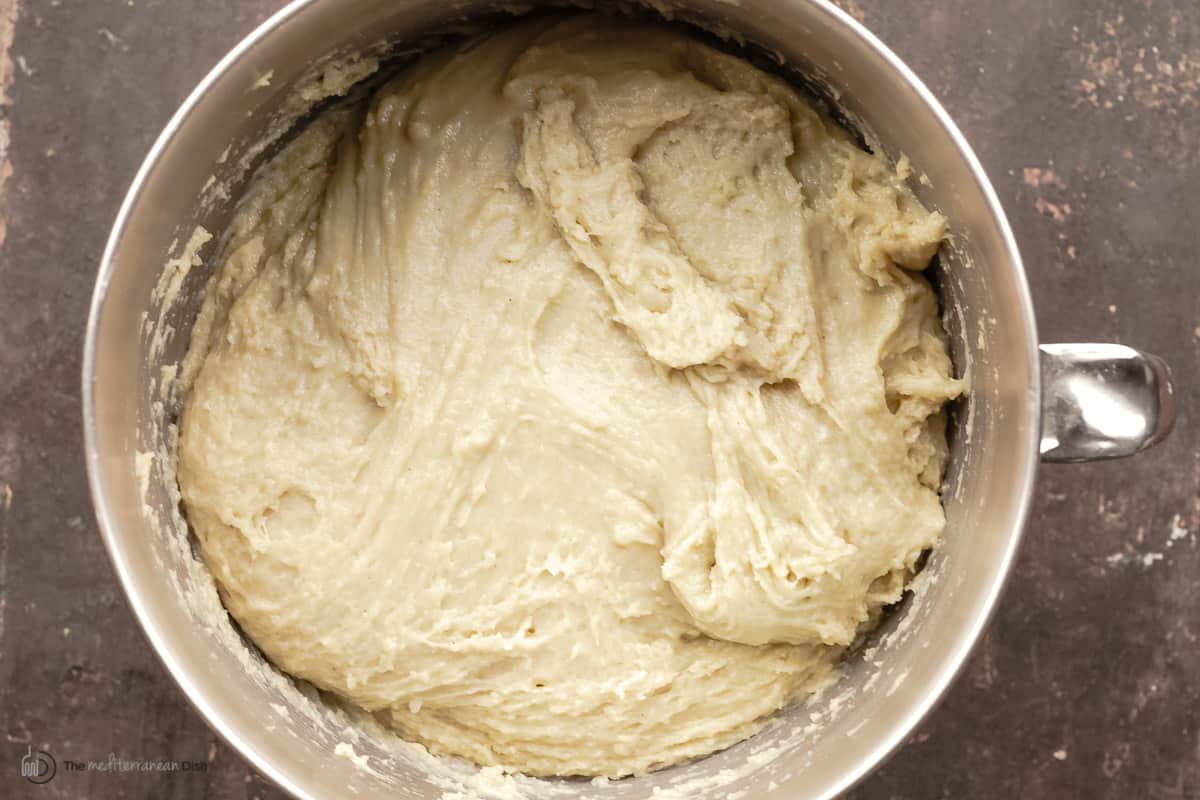
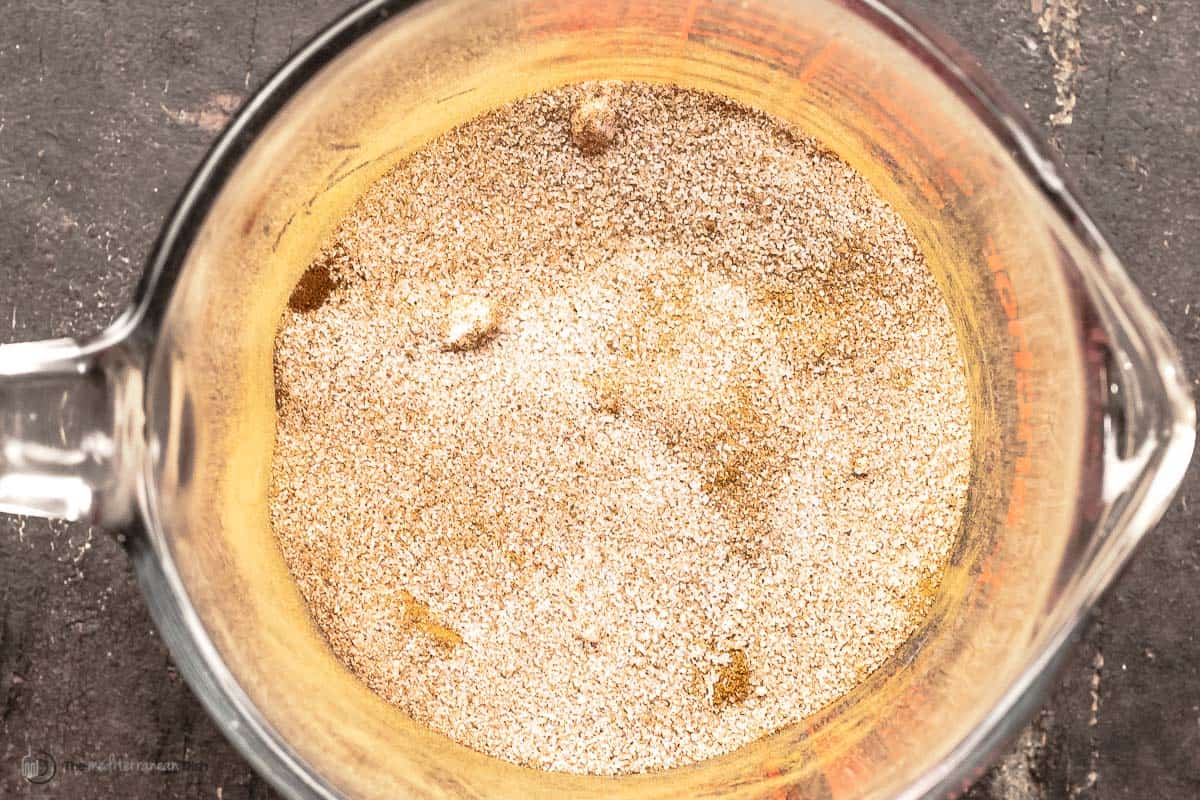
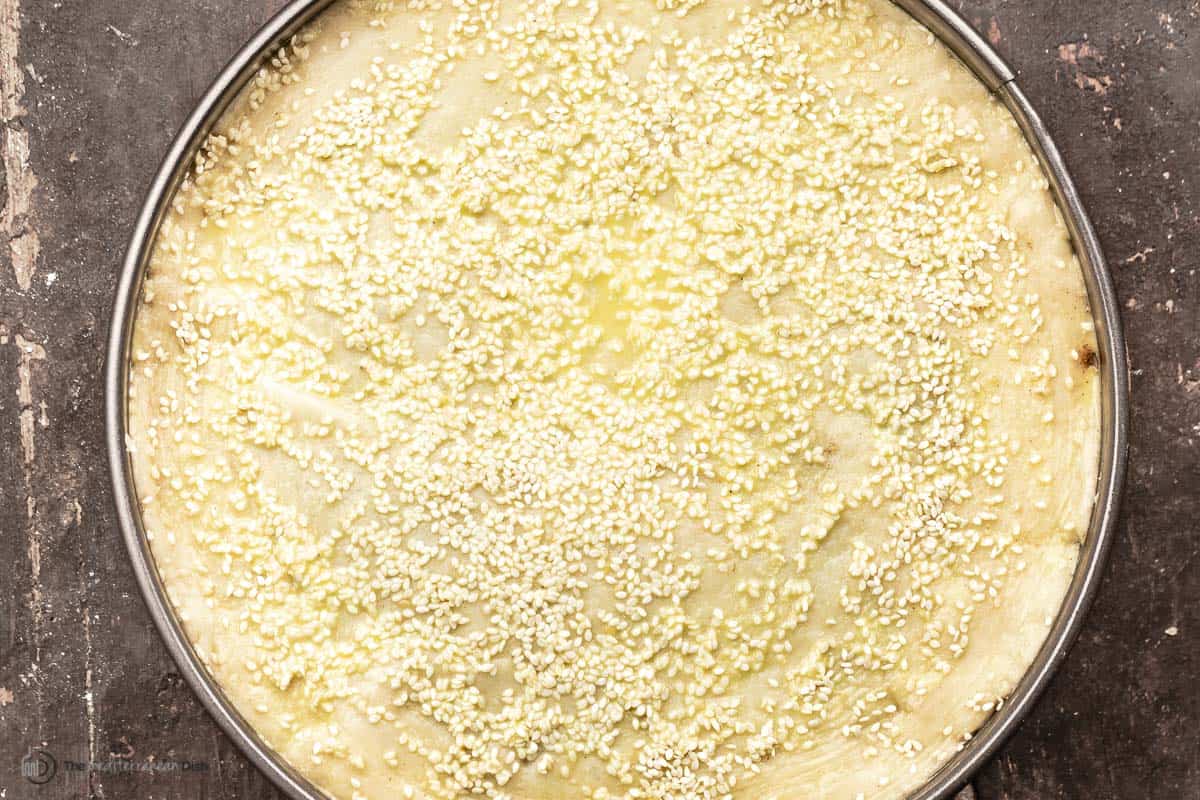
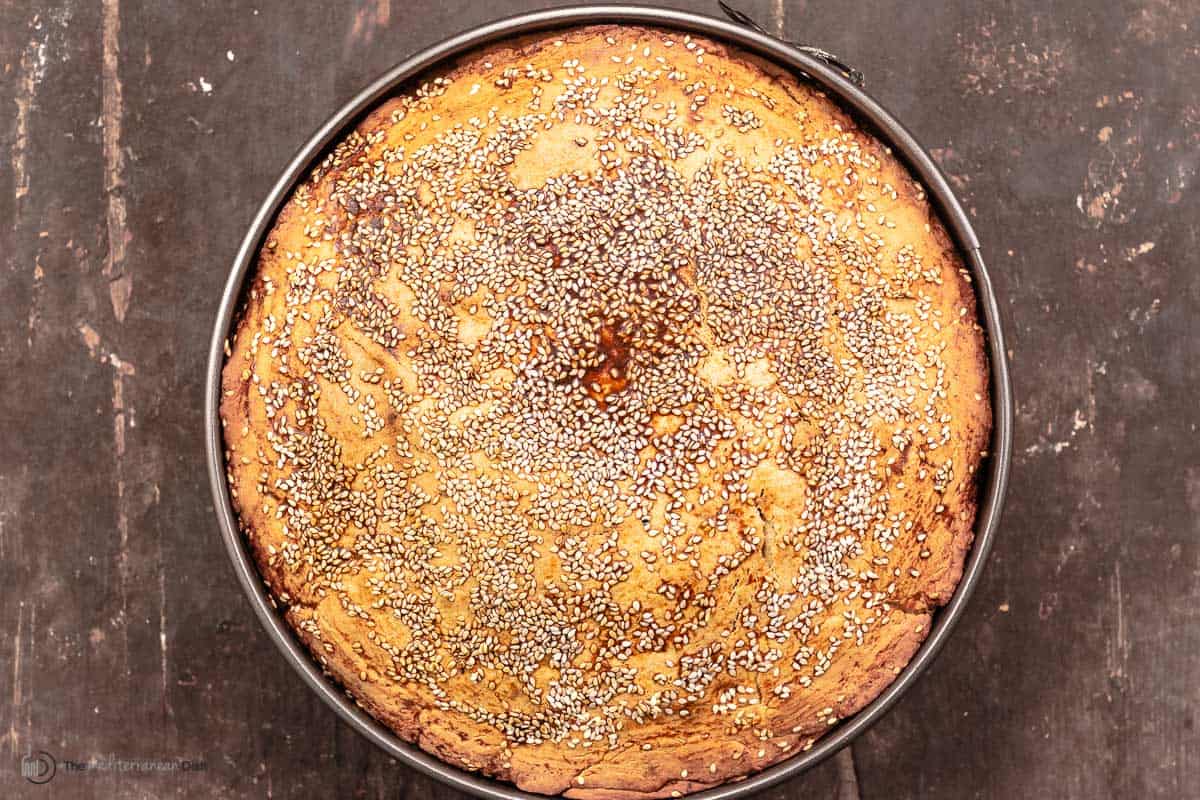
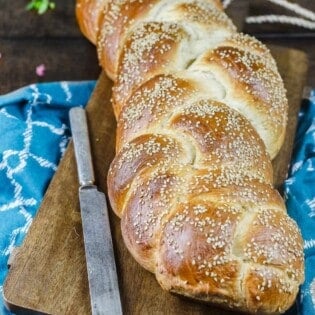
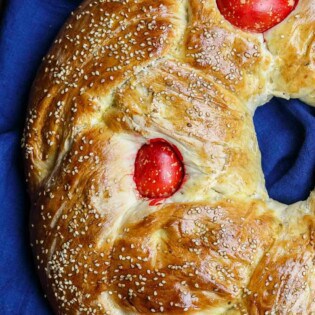
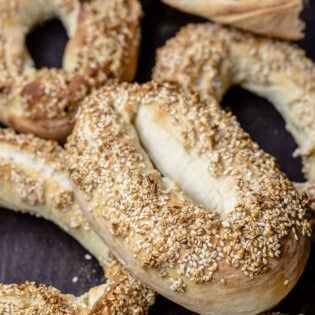
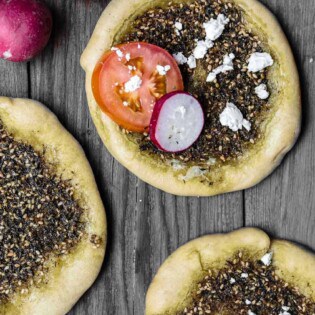
Ohhhh my goodness! THIS is the New year’s Eve Bread I grew up with! Unfortunately, the recipe was lost with time. My paternal grandmother was from Agiasou, and my grandfather from Vrisa. Both small towns are on the Island of Lesbos. I’m so glad you mentioned Mytilini. This must have been a very regional bread recipe. I am SO happy to see it here!! Cannot wait to try it. It looks like a lot of work, but I have my ancestors behind me! THANK YOU!
Hi Ann, Devin here from the Mediterranean Dish. I shared this comment with the whole team and it really warmed our hearts. Thank you so, so much for sharing. Please do let us know how it turns out. Καλή Χρονιά – Happy New Year!
Thanks for this recipe. My paternal grandmother made this. Because she had no recipe per se, we thought this was her creation. Needless to say, we were wrong.
Even when she made a door stop, it always teasted great when toasted and smothered with butter.
So glad you rediscovered an old family favorite! Thank you for stopping by and sharing your story!
Your recipes are out of this world
Awww! Thanks, Robyn!
This recipe is awesome! I made this last night!
I want to make 2 . Should I double 7-8 cups flour to 15-16 cups?
First time I’m making this vasilopita!
Thank you ❤️
Hi, Karmen. I have not made a double batch of this recipe, so I’m not quite sure how it would turn out. What might be better is mixing the 2 batches of dough separately.
Hi Suzy,
The comment above references doubling 7-8 cups of flour, but the recipe mentions 8-10 cups of flour. Which is correct? I only ask because I’ve made this twice and both times the result has has distinct layers of dough (think a stack of pancakes) as opposed to how it is in your picture, and the baking time is nearly 35min longer than the recipe indicates. The only thing I changed is I’m using a 9inch springform instead of a 10inch, so I scaled the recipe down 0.81x.
Hi, Matt. The recipe calls for 8-10 cups of flower. Sorry for the confusion. I was more focused on her reference to “doubling” than the actual numbers she mentioned in her question.
I am going to make this for New Year’s Eve! I tested this cake out to make sure I got the recipe down, and oh my gosh! So good! I can’t wait to cook it with the coin!!
So excited! Now we don’t have to wait for the King Cake at Mardi Gras! Thanks so much for this. Will be trying this New Year’s!
Yay! Thanks, Blake!
Absolutely divine! Definitely making this again for a special treat on New Year’s Day!
Awesome! Thank you, Lauren!
This was AMAZING!!! My yiayia used to make it. I had searched and searched online and was never able to find. Recipe until this came up. Was perfect and brought back so many memories. LOVED IT!! Is a time consuming dish, but well worth it.
Thanks, Eleni! So glad this was a hit for you!
You have in your ingredients for the dough 1/2 tsp of cinnamon but no where do you say when to add it.
Hi, Joanne. Thanks for catching that. The 1/2 tsp cinnamon is added when making the dough.
How thin do you make the layers. I’ve made it but I feel the layers weren’t quite right. I thought I did them thin enough but it tasted weird to me. My family loved it but not me. I feel I’m missing something. When I heated it up it tasted / smelt doughy . The layers were also able to be separated quite easily. Is that normal
This brings back warm vivid memories and the anticipation of who was going to
get lucky and get the coin in their bread slice. There were big disputes when the coin fell between two slices.
Lol! We’ve had similar disputes :).
For those of use that don’t understand what a stick of butter, could you include the cup measurement. Thank you.
Hello! Each stick of butter = 1/2 cup. Enjoy!
The official Golden Vasilopita Coin is available at Vasilopita.com
Thanks for the info, Elias!
This looks very interesting. A must try.
Hope you enjoy it, Hannah!
Can you substitute bread flour?
Hi, Karen. I haven’t tested this recipe with bread flour, so I can’t speak to if it would work. I’m sorry.
Thanks so ,much for that wonderful recipe, Suzy and many thanks for all your other recipes!
Have a great Christmas with your family!
Thanks, Renée! Same to you!